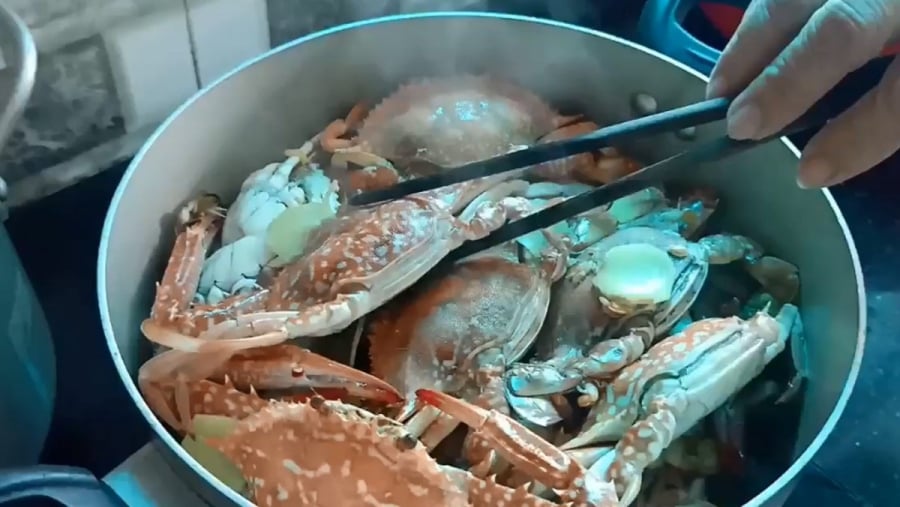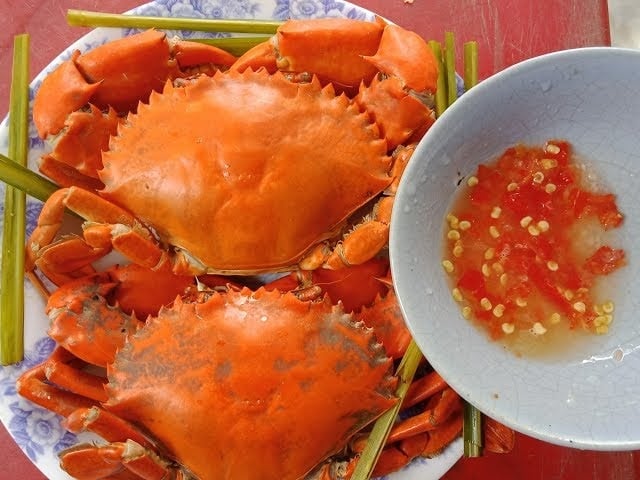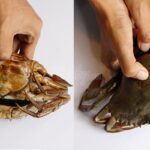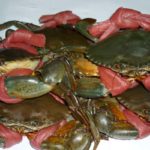Choosing Live Crab and Shrimp

A Simple Trick to Boil Crabs and Shrimp Without Losing Their Legs
When it comes to selecting live crabs and shrimp, go for those that are still active and move flexibly. A quick way to test their freshness is by touching their legs and claws; if they curl up rapidly, that’s a good sign. Additionally, press on their shell or abdomen; if it feels firm and not bloated, they’re likely meaty.
Male crabs tend to have more meat, while female crabs are known for their roe, so choose according to your preference.
Washing Crabs and Shrimp the Right Way
Use a small brush to scrub the outer surface of the crabs and shrimp, paying extra attention to the areas around their legs and claws. Soak them in a solution of diluted salt water or rice washing water for about 10-15 minutes to remove any dirt or residue.
After cleaning, it’s important to tie their legs securely with a string to prevent leg loss during boiling.
The Right Way to Boil Crabs and Shrimp Without Losing Their Legs
– Stun the crabs and shrimp before boiling: Place them in the freezer for about 15-20 minutes or soak them in ice water. This will cause them to faint, reducing leg loss during boiling.
– Boil crabs and shrimp in cold water: Instead of adding them to already boiling water, place the crabs and shrimp in a pot of cold water and then turn on the heat. Gradually increasing the temperature will help kill them slowly, reducing leg loss.
– Leave a small gap in the pot lid to prevent sudden temperature changes, which can cause thermal shock and lead to leg loss.
The ideal boiling time for large sea crabs is 15-20 minutes, while smaller sea crabs and shrimp take about 10-15 minutes.
Some tips for enjoying your crabs and shrimp: Once they’re cooked, remove them from the pot immediately to avoid overcooking, which can make the meat mushy. Use pliers or a knife to crack them open easily.

The Trick to Boiling Crabs and Shrimp Without Losing Their Legs: Stun Them with Ice Water First
How to Distinguish Between Roe Crabs and Meat Crabs
Distinguishing between roe crabs and meat crabs is not as complicated as you might think. Here are some simple tips to help you identify them:
Observe the Crab’s Apron
Roe crabs have an apron (the small flap on the underside of the crab) that is usually light yellow or pale orange in color. This indicates the presence of roe. When you gently squeeze the apron, it should feel firm and sturdy. Additionally, the apron of a roe crab is typically round and more prominent. This apron serves to hold the eggs during the breeding season, and it’s also where the delicious, fatty roe accumulates.
On the other hand, meat crabs have a smooth, white apron that is less noticeable. When squeezed, the apron of a meat crab feels softer and doesn’t give the same heavy sensation as a roe crab’s apron. The apron of a meat crab is typically triangular in shape, which is characteristic of male crabs. These crabs are known for their firm, sweet meat and usually have little to no roe.
Differences in Weight, Legs, and Claws
Roe crabs tend to be heavier than meat crabs of the same size due to the presence of roe. When you pick them up, they should feel substantial and not light. Meat crabs, on the other hand, are lighter but still have a full meat yield if their shell feels solid and heavy.
The legs and claws are also a good indicator. Meat crabs have larger, more robust legs and claws compared to roe crabs. Conversely, roe crabs have thinner, smaller legs as their energy is focused on producing roe rather than growing larger limbs. When you gently press the end of a leg or squeeze a claw of a meat crab, you should feel firmness, indicating thick and meaty crab legs and claws.
Observing After Cooking
If you weren’t able to distinguish between roe and meat crabs beforehand, you can still identify them after cooking. Roe crabs have a distinctive yellow-orange or dark red roe, emitting a savory aroma. The roe is usually found in the shell and attached to some of the meat. Meat crabs, on the other hand, lack roe but make up for it with their firm, sweet meat.
The Ultimate Guide to Buying Crab: Target This Spot for Sweet, Firm, and Fresh Meat
For those with a penchant for seafood, especially crab lovers, taking note of a few key details can elevate your dining experience. Seasoned fishermen with a knack for catching the tastiest treats from the sea share their secrets to selecting the choicest crabs, ensuring every bite is a burst of savory delight.
The Ultimate Guide to Picking Meaty Crabs and Crabs: A Surefire 10 out of 10 Method
For those who relish the taste of crab meat, it’s all too easy to end up with a watery, meager offering. But fear not, as we’re serving up the ultimate guide to choosing the tastiest, meat-filled crabs and sparing your hard-earned cash. Get ready to indulge in the very best that the sea has to offer!
The Ultimate Guide to Steaming Crabs and Spicy Crawfish: A Culinary Adventure
Unleash the culinary artist within and embark on a gastronomic journey with our simple yet mouth-watering crab and lobster preparation, cleaning, and steaming guide. Discover the secrets to transforming these crustaceans into a culinary masterpiece with our expertly crafted tips and tricks, revealed right here. It’s time to elevate your seafood game!
The Ultimate Guide to Selecting the Freshest Seafood While Traveling
Summer is the prime season for beach vacations, and many people enjoy indulging in fresh seafood during their travels. It’s not uncommon for enthusiasts to buy a plethora of seafood when they get the chance to go on a seaside trip. However, how do you ensure that you’re selecting the freshest and most delicious seafood? Join us as we explore some handy tips to become a master at choosing the best seafood!






































